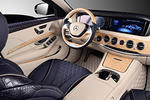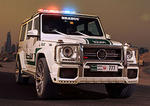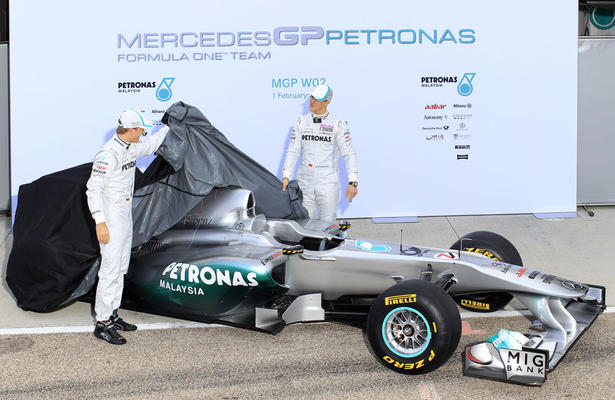
Mercedes GP has unveiled today the new Mercedes 2011 F1 car called the MGP W02, which will be driven in the 2011 FIA Formula 1 World championship by Michael Schumacher and Nico Rosberg. The Mercedes 2011 F1 car is powered by a Mercedes-Benz FO108Y 2.4-liter V8 engine with a maximum rev range of 18,000 (maximum FIA regulation). The Mercedes 2011 F1 car measures 4800mm in length, 950mm in height and 1800mm in width, and is built on a molded carbon fiber and honeycomb composite chassis. The suspension system of the Mercedes 2011 F1 car features wishbone and pushrod activated torsion springs and rockers with Penske dampers.
The Mercedes 2011 F1 car features a seven speed transmission unit with a cast aluminum maincase,
sequential, semi-automatic, hydraulic activation and a carbon plate clutch.
Just as the other 2011 Formula 1 cars, the Mercedes 2011 F1 car has KERS, an adjustable rear wing and no F-Ducts and double diffusers.
Mercedes 2011 F1 car specs:
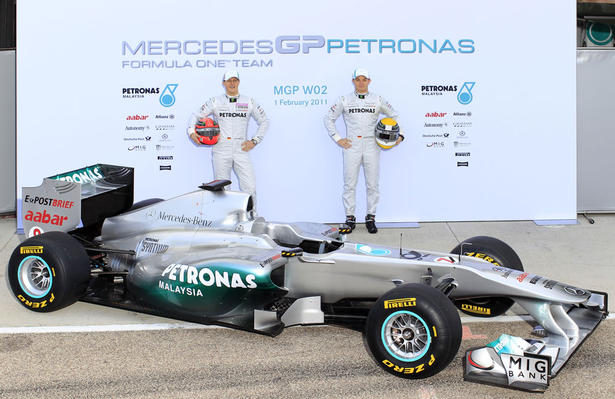
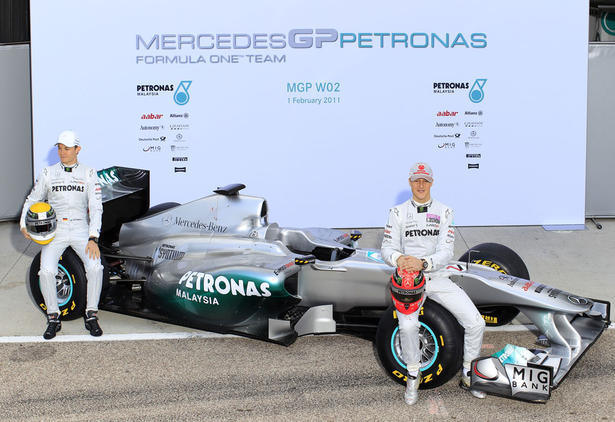
MGP W02 Technical Specification
Chassis
Construction Molded carbon fiber and honeycomb composite structure
Suspension Wishbone and pushrod activated torsion springs and rockers
Dampers Penske
Wheels BBS forged magnesium
Tyres Pirelli
Brakes Brembo calipers
Brake discs/pads Carbon/Carbon
Steering Power assisted rack and pinion
Steering wheel Carbon fibre construction
Electronics FIA standard ECU and FIA homologated electronic and electrical system
Transmission
Gearbox Seven speed unit with cast aluminium maincase
Gear selection Sequential, semi-automatic, hydraulic activation
Clutch Carbon plate
Dimensions
Overall length 4800mm
Overall height 950mm
Overall width 1800mm
Engine
Type Mercedes-Benz FO108Y
Capacity 2.4 litres
Cylinders 8
Maximum rpm 18,000 (maximum FIA regulation)
Bank angle 90°
Piston bore 98mm (maximum FIA regulation)
No of valves 32
Weight 95kg (minimum FIA regulation weight)
2011 Formula One Regulation Changes
Tyres
Pirelli takes over from Bridgestone as the sport’s sole tyre supplier from 2011 to 2013. The tyre allocation for each driver remains at 11 sets of dry tyres per race weekend. Three sets (two prime & one option) can be used in P1 and P2 with one set returned after each session. A further eight sets can then be used for the rest of the weekend with one set of each specification handed back after qualifying. Each driver must use both specifications of dry tyres during a dry race.
KERS
First introduced in 2009, KERS (Kinetic Energy Recovery System) returns to the sport in 2011 after the teams mutually agreed to suspend its use in 2010. KERS uses the energy generated under braking and makes it available to the driver through a boost button on the steering wheel. The button, which provides up to 60kW for around 6.6 seconds, can be used in one go or at different points around the lap. The minimum weight of the car including driver has now increased to 640kg to avoid penalising heavier drivers.
Adjustable Rear Wings
Drivers are now able to adjust the rear wing from the cockpit under new moveable bodywork regulations designed to improve overtaking. The system is electronically governed and can be used at any time during practice and qualifying but can only be activated during the race when the driver is one second or less behind another car at specific points on the track. The adjustable rear wing is automatically disabled if the driver uses the brakes.
Ban on F-Ducts & Double Diffusers
A new regulation prohibits any driver-influenced aerodynamic devices (with the exception of the adjustable rear wing) which means no F-ducts. Tightening of the regulations relating to the floor means double diffusers are also effectively banned. The height of the diffuser has been reduced from 175mm to 125mm.
107% Qualifying
Any driver who fails to set a lap within 107% of the fastest Q1 time will not be allowed to start the race. However, in exceptional circumstances, which could include a driver setting a suitable time during practice, the stewards may permit the car to start.
Curfew
A curfew has been introduced for team personnel associated with the operation of the cars who will not be allowed in the circuit during a six-hour period which commences ten hours before the scheduled start times of P1 on Friday and P3 on Saturday. Each team is permitted four individual exceptions to this rule during the season.
Penalties
Stewards can now impose a wider range of penalties for driving and other rule transgressions. The new penalties include: time penalties, exclusion from race results or suspension from subsequent events.
Wheel Tethers
A second tether must now be placed on every wheel to improve safety and reduce the risk of stray wheels.
Gearboxes
Gearboxes now need to last for five race weekends, instead of four race weekends as in 2010.
Team Orders
The clause which bans team orders has been removed from the Sporting Regulations









